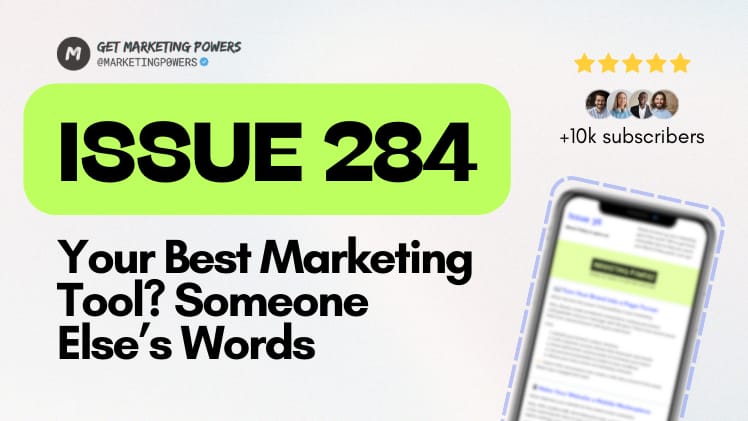- The Strategy of Marketing: Get Marketing Powers
- Posts
- Your Best Marketing Tool? Someone Else’s Words - Issue 284
Your Best Marketing Tool? Someone Else’s Words - Issue 284
Why Testimonials Beat Taglines Every Time

Hey there,
When it comes to choosing a brand, people don’t trust ads.
They trust other people.
Before they click “Buy” or “Book a Call,” they ask:
“Has this worked for anyone like me?”
That’s why social proof is your secret weapon.
→ It removes friction.
→ It builds trust.
→ It boosts conversions and SEO.
This week, we’re showing you how to harness testimonials, reviews, case studies, and more to turn traffic into trust and clicks into customers.
Let’s dive in.
🚨 The Problem: You’re Doing the Work, But Not Showing the Results
You’ve helped customers.
You’ve solved real problems.
You’ve driven outcomes.
But you’re not showing it and prospects can’t see it.
❌ No recent testimonials
❌ No case studies
❌ No customer stories
❌ No review strategy
So… your brand looks generic. Risky. Forgettable.
✅ The Fix: Systematically Leverage Social Proof Across Every Funnel Stage
Your visitors need reasons to believe.
→ Not from you - but from people like them.
Let’s build a social proof engine that sells for you.
This week, we’re covering:
✔️ What types of social proof work best
✔️ Where to use them
✔️ How they double as SEO assets
✔️ And how to gather proof without making it awkward
An eCommerce brand saw product page bounce rates skyrocket after redesigning their site — even though they improved page speed and visuals.
The missing piece? Reviews.
They reintroduced:
→ ⭐ Star ratings
→ ✅ “Verified Buyer” testimonials
→ 📸 UGC photo submissions
With schema markup, they also appeared in Google rich snippets.
Results in 30 days:
📈 22% higher conversion rate
🔗 11 new backlinks from “best product” blog posts
🔍 Featured snippets for “Product Name + Reviews”
The trust signals didn’t just convert - they boosted SEO.

1️⃣ Add Case Studies to Key Landing Pages
Why it works: Shows real results for real people.
📈 Great for bottom-of-funnel visitors.
🎯 Tip: Use client quotes + specific metrics (e.g. “increased revenue by 38% in 90 days”).
📍 Where to place:
→ Service pages
→ Sales pages
→ Book-a-call pages
2️⃣ Feature Testimonials Strategically
Why it works: Relatable feedback reduces perceived risk.
🎯 Tip: Tag testimonials by persona (“Startup CEO,” “Marketing Director”) for relevance.
📍 Where to place:
→ Homepages
→ Pricing pages
→ Exit-intent popups
→ Email nurturing flows
3️⃣ Implement Review Schema Markup
Why it works: Makes reviews visible before users even land on your site.
🎯 Tip: Add schema to product pages, software reviews, or services.
📍 Benefits:
→ Rich snippets in Google
→ Higher CTR
→ SEO visibility
4️⃣ Collect and Display UGC (User-Generated Content)
Why it works: Real customers. Real results. Real photos. It doesn’t get more authentic.
🎯 Tip: Use hashtags or post-purchase email flows to request content.
📍 Where to use:
→ Product pages
→ Instagram stories
→ Email footers
Why it works: Puts all proof in one powerful place. Builds momentum.
🎯 Tip: Combine tweets, screenshots, videos, and quotes.
📍 Where to host:
→ Dedicated page on your site
→ Link in bio hub
→ Slide-in site widget
Why it works: Every case study, review, and testimonial is a content opportunity.
🎯 Tip:
→ Publish “How [Customer] Achieved [Result]” blog posts
→ Use keywords your buyers search for: “[Your brand] reviews,” “[Problem] solved,” etc.
✅ This Week’s Action Plan:
📌 Collect at least 3 new testimonials or case study quotes
📦 Update your best-performing landing page with social proof
🔍 Add schema markup to key product/service pages
📸 Ask customers for UGC via email (with examples)
📄 Turn 1 case study into a keyword-rich blog post
You don’t need to write better copy.
You just need to let your customers do the talking.
Let’s build trust that scales and ranks.
Talk soon,